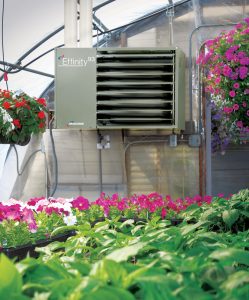- Thermostats
- Clean thermostats regularly. A dirty thermostat will not accurately sense temperature. Calibrate thermostats annually. If purchasing a new thermostat or controller use electronic models with 1°F differentials.
- Furnace Check-up

- Have furnaces and unit heaters serviced and tested yearly. Replace older inefficient furnaces. A 2% increase in efficiency will save about 125 gallons of fuel oil, 190 gallons of propane or 174 Therms of natural gas per year for a 28-foot by 100-foot greenhouse. This savings would more than pay for the inspection and tune up for your heating systems for the coming winter.
- Gas Burners – Flame should burn as blue as possible; yellow flame indicates insufficient air. Check gas supply line pressures, check all fittings for leaks.
- Oil Burners – Replace the nozzle with one that meets the furnace manufacturer’s specifications. Change oil filters twice per year. Check pump output pressure, typically between 100 -120 psi; low pressure causes incomplete combustion. Check spark jump between igniter contacts; new 14,000-volt electronic igniters are recommended. Clean igniter contacts and ignition sensors. At temperature below 20°F oil viscosity increases, water droplets freeze and paraffin precipitates out. Moving the oil storage tank inside, adding fuel treatments and raising pump pressures can reduce problems
- Chimneys – Should be air tight, same diameter as the furnace connection, at least 8 foot high and at least 2 foot above the greenhouse peak. A chimney cap will reduce back-drafts and keep rain out.
- Have furnaces and unit heaters serviced and tested yearly. Replace older inefficient furnaces. A 2% increase in efficiency will save about 125 gallons of fuel oil, 190 gallons of propane or 174 Therms of natural gas per year for a 28-foot by 100-foot greenhouse. This savings would more than pay for the inspection and tune up for your heating systems for the coming winter.
- Central Heating
- Insulate pipes and air ducts in headhouses and boilers rooms. Many headhouses are over heated because of poor insulation of heating pipes running through to the greenhouse. Insulation is simple to install and usually has paybacks of less than two years. Each uninsulated linear foot of a 2-inch heating supply pipe will loose about $4 worth of heat this winter.*
- Have the heating system serviced regularly. This includes soot removal inside the firebox, changing fuel filters, cleaning nozzles, checking valves and controls, checking and aligning belts, lubricating bearings and testing combustion efficiency. Soot can build up in fire tubes due to incomplete combustion of fuel caused by improper air to fuel ratios or plugged nozzles. An 1/8″ of soot deposit can increase fuel consumption by 10% or more.
- Bottom Heating

- Moving heating pipes and air distributions systems from overhead to under bench, on-floor or in-floor can save 20-25% in heating costs and results in faster plant growth. One study reported a 7% average yield increase from greenhouse tomato production, thought occurred largely due to a 7°F higher root medium temperature. A heating pipe under the gutters will still be needed on gutter connected greenhouses to aid in melting snow.
- Alternate Fuels
- If a central heating system is used, it may be easier to take advantage of alternate fuels such as wood or other bio-mass. Before investing in alternate fuel, make sure you are considering all costs (labor, maintenance, ash removal and ash disposal) and check with state environmental regulatory agency about permits and ash disposal requirements.
- Waste Heat / Cogeneration
- Cogeneration opportunities using waste heat are limited to sites adjacent to power plants or industrial sites. The waste heat source must be able to dependably supply 90º – 100ºF water. A radiant floor system is ideal for this system. Depending on the purchase agreement, energy costs can be reduced substantially. Cogeneration may also be accomplished by powering an electrical generator with an internal combustion engine. The electricity not used for greenhouse operations is sold to the utility while recovering the waste heat from the engine cooling system and exhaust system for heating the greenhouse. The method can result in an overall efficiency of about 75%; 25% for the conversion of electricity and 50% for the use of waste heat. The disadvantage of such a system is the initial cost and maintenance and the need to have a backup heating system.
References:
Greenhouse Unit Heaters: Types, Placement, and Efficiency (2011), Scott Sanford, A3907-02, 6 pp, University of Wisconsin Extension, Madison, WI. Available at: https://learningstore.extension.wisc.edu/Assets/pdfs/A3907-02.pdf
* “Grower 101: Heating Systems – Maintenance Pays”, Bartok Jr, J.W., Greenhouse Product News, September 2003, Vol 13, No. 9, Pg 56-59. Available at: http://www.gpnmag.com/article/grower-101-heating-systems-maintenance-pays/
If you have questions about the information on this site, please contact
Scott Sanford, Distinguished Outreach Specialist, University of Wisconsin, sasanford@wisc.edu.



